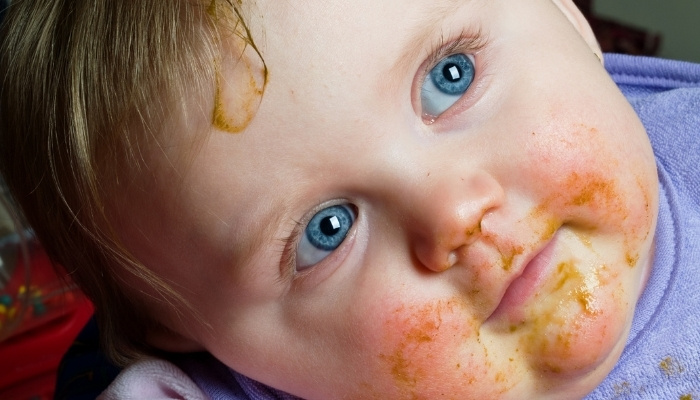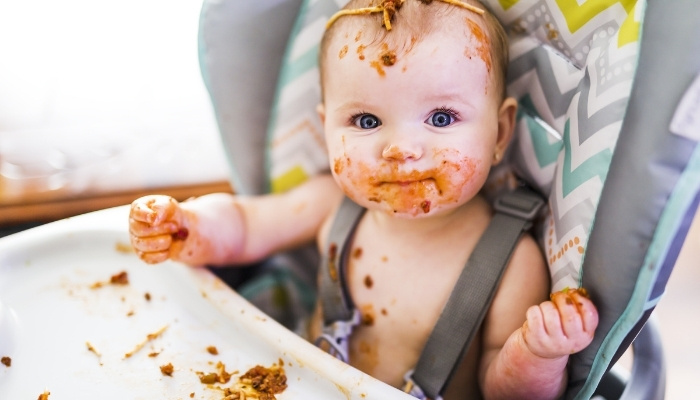Do you anticipate your child starting to try solid food after weaning? Get ready for an exciting but potentially messy journey that will also be rewarding. Thankfully, there are various ways to ease this transition for both you and your child.
1. Get Clearance From Pediatrician Before Beginning
Before baby-led weaning can be successful, your child’s digestive system needs to be ready. It’s recommended that you wait until your child is at least six months old before you start offering anything besides breast milk or formula.
For babies who were premature or have health issues, this may still be too early. That’s why it’s essential to talk to your pediatrician first.
2. Use Pocket Bibs, Smocks, or Splat Mats
Want less mess that’s easier to clean at the end of the meal? Grab items designed for baby-led weaning.
The Bumkins SuperBib is waterproof and has a pocket to catch foods your child will inevitably drop.
If you’re looking for a smock that will cover more of your child while they attempt to shovel food into their mouth, the Tiny Twinkle Mess Proof Baby Bib will not disappoint. Use the Velcro in the back to keep your child’s front fully covered while they eat.
It’s also super easy to protect your floors by getting a mat made for baby-led weaning. The Splat Mat goes under your child’s high chair to make after-meal cleaning easier every time.
3. If You Use Bowls or Plates, Use Ones With Suction Cups
It may be tempting to teach your child how to use bowls and other utensils right out of the starting gate. This is definitely an option, but beware! There will absolutely be a mess if you don’t choose the plates and utensils designed for this work.
Bowls and plates with suction cups to hold them in place (these are perfect for getting started) will save you a lot of time and energy. Food may still end up on the floor, but it won’t be hurled there in one swift motion, plate included.
4. Don’t Have High Expectations the First Few Times
Some kids cannot wait to try food for the first time. Some absolutely refuse to let anything besides breastmilk or formula past their lips.
Don’t stress about it either way. Your child has to learn how to eat, and that takes longer for some kids than it does other kids.
There’s a saying: Food before one is just for fun! You should try baby-led weaning during your child’s first year, but most of their nutrients will still be coming from breast milk or formula.
5. Demonstrate Picking Up Food and Chewing
Show your child what you expect them to do by doing it yourself. Pick up the food you want your child to try and show them that you are chewing it. This gives them a goal to aim for and demonstrates what you want.
6. Start With Soft Foods That Are Easy To Grasp
You want to start with foods that are easy for your child to hold and easy for your child to chew. Avocados, bananas, melon slices, and cooked sweet potatoes are all good options.
7. It’s Okay To Also Offer Purees or Baby Food
Baby food and purees are not the enemy, so don’t be afraid to offer them to your child. It’s sometimes easier for your child to get the hang of learning to chew with a food that is already soft and easy to swallow.

8. Stick to Healthy Choices To Establish Good Habits
Don’t offer your kids unhealthy food just because you want them to eat. You are establishing habits with baby-led weaning, and you want making healthy food choices to be one of them.
Offer your child foods you want them to eat so they will get used to the taste and crave those foods.
9. Cut Food Into Manageable Pieces
Your child does not have enough teeth to break food into smaller pieces while chewing. You need to make sure to cut your child’s food into manageable pieces before you offer to let them eat it.
Doing this will help you avoid choking issues and will encourage your baby to get better at grasping.
10. Let Your Baby Have Fun & Explore
If you want your child to associate meal time with positive feelings, let them have some fun. Your child is going to want to play with the food before, during, and after they eat it.
While it’s okay to set boundaries, make sure you leave room for your child to truly enjoy mealtime, even if some of the food misses the mouth.
11. Expect Some Food To Be Spit Out
Your child will not like everything you offer. Some of it will absolutely end up being spit out, and that’s okay. Expect the mess, and keep trying.
You can even reintroduce a food your child didn’t like in a month or so and see if they are more accepting then.
12. Do Not Scold for Messes
You’re going to clean a lot of food off of everything in your house. That’s just part of the process. Try not to scold your child for messes because this can take away the joy of meal time.
If your child is scared she’s going to get in trouble every time she’s in her high chair, getting her to eat is going to get much harder.
13. Eat Meals Together as a Family
Even when they’re young, our kids are watching what we do. Eating together as a family lets your child feel included and allows them to mimic your actions. It also gives your child a focus since everyone is sitting down and eating together.
14. Know the Signs of Choking and What To Do
No one wants to think about their child choking, but it can happen. I have done the Heimlich maneuver on my kids, and I’m glad I knew how.
Make sure you know the signs of choking, which may include: coughing, gagging, wheezing, or turning blue. You should also know how to perform the Heimlich maneuver based on your child’s age so you can intervene should they choke.
15. ALWAYS Supervise
You need to actively supervise every time your child eats. There is never a time when walking away is acceptable. Besides choking, your child could also fall out of their high chair. It’s essential that you are present and watching at each meal.

16. Only Offer Food in the High Chair
Though your child may want to be on the move constantly, they should not scoot and eat. Make sure that any time you offer food, your child is in the high chair.
It’s easier to supervise meals this way, and it signals to your child that eating takes place in a specific area. This is a good habit from day one.
17. Keep Records of Foods Eaten
Start keeping a record the first time you give your child food, and keep it up throughout the baby-led weaning process.
This will help you track your child’s reactions to each food, and it may also allow you to figure out what your child is allergic to if that becomes an issue.
18. Know the Signs of Allergic Reactions
Your child may happily devour every food you give them with no complications. However, there’s always a chance that your child will have an allergic reaction to something they’re introduced to when weaning.
Signs of an allergic reaction include:
- Vomiting
- Diarrhea
- Hives
- Rash
- Wheezing
- Breathing problems
If any of these occur, seek medical attention.
19. Continue Breastfeeding or Bottle-Feeding
Your baby will not get enough nutrients through food when they start baby-led weaning. Continue bottle-feeding or breastfeeding to ensure your child grows and develops properly.
You won’t be stressed if your child is resistant to food when you know she is still getting what she needs from breast milk or formula.
20. Let Baby Set the Pace
Don’t make baby-led weaning about your expectations. Let your baby take the lead and enjoy a much smoother journey.
Look for signs that your child is ready for food and recognize the signs she gives when she is not. Honor what your child chooses, and plan to pace the process around your child’s needs.
21. Gradually Introduce Harder Foods as Baby Matures
Your child is not going to be ready for a ton of new foods all at once. Save foods that are harder to chew for later. As your child grows more teeth and gets better at chewing, they will be able to enjoy harder foods without a high risk of choking.
22. Make Sure That all Caretakers Know What Foods Are Safe
Need a date night and have a sitter? Great! Just make sure anyone (including older siblings and grandparents) who keeps your child knows what foods are safe for them to eat. If your child has food allergies, this is especially important.
23. When in Doubt, Ask Your Doctor
If you have questions about your child’s eating habits, ask your doctor. There are situations where a medical condition could be at the root of your child’s eating issues.
Your doctor can help you figure out if there is anything going on that is keeping your child from enjoying mealtime.
Closing Thoughts
Baby-led weaning is a huge step in your child’s development. Get ready for a mess, and enjoy the ride!
Kristy is the mother of four, including identical twins. With a background in education and research, she is constantly learning more about parenting and raising multiples. When she has spare time, she enjoys hiking into the woods with a great book to take a break.

